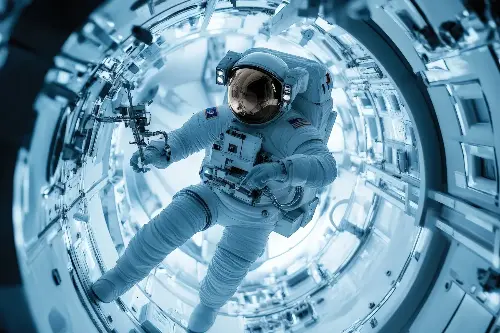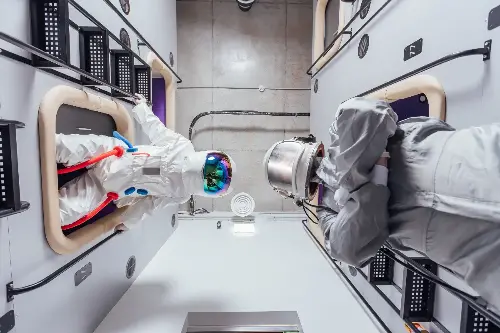Space: the final frontier. It's not just a realm of scientific exploration but a place where our very bodies undergo profound transformations. As humanity continues to reach beyond Earth's atmosphere, understanding the effects of space on astronauts' health and bodies becomes paramount. The unique environment of space presents a constellation of challenges that impact everything from an astronaut's muscular strength to the depths of their vascular system.

The Microgravity Phenomenon
One of the most immediate and striking effects of space is microgravity. On Earth, gravity pulls blood and fluids downwards towards our legs, but in space, these fluids distribute more evenly throughout the body. This shift results in the characteristic 'puffy face' syndrome seen in many astronauts. Additionally, microgravity leads to loss of bone density and muscle mass, as the body no longer needs to support weight or maintain posture. Astronauts can lose up to 1-2% of bone mass per month, raising concerns about osteoporosis and fractures upon their return to Earth.
To combat these effects, astronauts engage in rigorous daily exercise routines using specially designed equipment like resistance machines that help simulate weight-bearing exercises. Nonetheless, the quest to understand and mitigate these changes continues, with studies focusing on nutrition, pharmaceutical interventions, and novel exercise regimes.
Radiation Beyond Earth's Shield
Beyond the cocoon of Earth's protective magnetic field, space travellers are exposed to higher levels of cosmic rays and solar radiation. This radiation can damage DNA, increasing the risk of cancer and other diseases. Strikingly, it also has the potential to affect the nervous system, leading to possible cognitive deficits and changes in vision, a condition known as spaceflight-associated neuro-ocular syndrome (SANS).
Cutting-edge shielding techniques, real-time radiation monitoring, and protective habitats are essential components of long-term space missions to minimise these risks. Moreover, research is exploring how antioxidants and other dietary strategies might protect astronauts at a cellular level.

The Heart of the Matter
The heart, the engine of the human body, also undergoes remarkable changes in space. In microgravity, the heart doesn’t have to work as hard to pump blood around the body, which can cause the heart muscles to weaken. This condition, akin to the terrestrial heart atrophy, requires a close monitoring of cardiovascular health before, during, and after space missions.
Furthermore, the lack of gravity means that the heart becomes more spherical, an alteration with unknown long-term effects. Understanding cardiac adaptations is a focus of ongoing research to ensure that astronauts maintain robust heart health, critical for enduring the streness of space travel.
Sleep and Rhythms Among the Stars
With a sunrise and sunset every 90 minutes in orbit, an astronaut's circadian rhythm – the natural body clock – can easily become disrupted. This disruption can lead to sleep disorders, impaired cognitive function, and mood changes. Thus, managing light exposure and maintaining a consistent sleep schedule are vital for both physical and mental well-being.
Special lighting systems that mimic the natural progression of daylight are part of the innovative approaches to create a semblance of Earth's day-night cycle and support healthy circadian rhythms in space.

The Psychological Sphere
The confined and isolated nature of space missions can also take a toll on an astronaut’s mental health. Living in close quarters with a small crew, separation from family, and the absence of natural landscapes can cause stress and anxiety. Extensive psychological support, including regular communication with loved ones and access to stress-relieving activities, is therefore crucial.
Virtual reality environments that simulate walks on the beach or forest hikes, and onboard hobbies and social events, help astronauts maintain their mental health during their time away from Earth.
Return to Gravity
After an extended stay in space, returning to Earth's gravity presents its challenges. Muscles and bones weakened by microgravity can make standing and walking difficult, and some astronauts experience a condition known as orthostatic intolerance – dizziness and fainting caused by standing up too quickly.
For this reason, recovery and rehabilitation become a significant focus post-mission. Customised physical therapies help astronauts readjust to Earth’s gravity, regain strength, and return to their daily lives, while also contributing valuable data to advance our understanding of the human body’s adaptability.

Looking to the Future
As we set our sights on longer missions and deeper space exploration to places like Mars, addressing the implications of space travel on the human body becomes even more critical. The continued collaboration between biologists, physicians, engineers, and astronauts will pave the way for new frontiers in space health and medicine, ensuring that as we reach for the stars, we don't lose sight of the human within the spacesuit.
From muscle wasting to radiation exposure, and from cardiac changes to psychological well-being, space presents a multitude of challenges to human health. Yet, each problem also presents an opportunity – to learn, to innovate, and to prepare for the next generation of space exploration. Engaging with these cosmic challenges ensures that when humanity does step onto distant worlds, we'll step with strength, resilience, and vitality.
